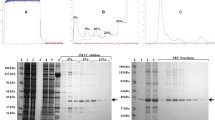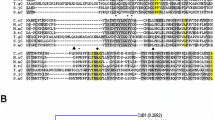Abstract
The serpins are a superfamily of proteins (350–500 amino acids in size) that fold into a conserved structure. From about 3,475 unigenes of Clonorchis sinensis metacercaria, a novel gene-encoding serpin was identified and characterized. The opening reading frame is 1,149 bp encoding 382 amino acids. The deduced amino acid sequence shows high identity to previously reported serpins from C. sinensis and other helminthic parasites. A typical serpin signature was found by motif search. The recombinant C. sinensis serpin protein (rCsproSERPIN) was produced and purified. Semiquantitative analysis revealed that the transcripts of this serpin gene in metacercaria were much higher than that in adult worms and that the corresponding band of serpin protein in the crude soluble antigen of metacercaria probed by rat anti-CsproSERPIN serum was also much clearer compared with that of adult, suggesting that it plays an important role in the stage of C. sinensis metacercaria. Although we are not much clear about the detailed function of this serpin protein, the study that proteinase initiates metacercaria excystment gives a clue that it may participate in the encystment of cercaria.





Similar content being viewed by others
References
Asanji MF, Williams MO (1975) Studies on the excystment of trematode metacercariae in vitro. Z Parasitenkd 47(2):151–163
Blanton RE, Licate LS, Aman RA (1994) Characterization of a native and recombinant Schistosoma haematobium serine protease inhibitor gene product. Mol Biochem Parasitol 63(1):1–11
Chung YB, Kong Y, Joo IJ, Cho SY, Kang SY (1995) Excystment of Paragonimus westermani metacercariae by endogenous cysteine protease. J Parasitol 81(2):137–142
Chung YB, Kim TS, Yang HJ (2005) Early cysteine protease activity in excretory bladder triggers metacercaria excystment of Paragonimus westermani. J Parasitol 91(4):953–954
Ghendler Y, Arnon R, Fishelson Z (1994) Schistosoma mansoni: isolation and characterization of Smpi56, a novel serine protease inhibitor. Exp Parasitol 78(2):121–131
Keiser J, Utzinger J (2009) Food-borne trematodiases. Clin Microbiol Rev 22(3):466–483
Knox DP (2007) Proteinase inhibitors and helminth parasite infection. Parasite Immunol 29(2):57–71
Lan Anh NT, Phuong NT, Johansen MV, Murrell KD, Van PT, Dalsgaard A, Thu LT, Thamsborg SM (2009) Prevalence and risks for fishborne zoonotic trematode infections in domestic animals in a highly endemic area of North Vietnam. Acta Trop 112(2):198–203
Lun ZR, Gasser RB, Lai DH, Li AX, Zhu XQ, Yu XB, Fang YY (2005) Clonorchiasis: a key foodborne zoonosis in China. Lancet Infect Dis 5(1):31–41
Marcos LA, Terashima A, Gotuzzo E (2008) Update on hepatobiliary flukes: fascioliasis, opisthorchiasis and clonorchiasis. Curr Opin Infect Dis 21(5):523–530
Marone M, Mozzetti S, De Ritis D, Pierelli L, Scambia G (2001) Semiquantitative RT-PCR analysis to assess the expression levels of multiple transcripts from the same sample. Biol Proced Online 3:19–25
Park YK, Hwang MK, Chung PR (2006) Encystment and metacercariae development of Echinostoma cinetorchis cercariae in an in vitro culture system. J Parasitol 92(5):1010–1013
Potempa J, Korzus E, Travis J (1994) The serpin superfamily of proteinase inhibitors: structure, function, and regulation. J Biol Chem 269(23):15957–15960
Silverman GA, Bird PI, Carrell RW, Church FC, Coughlin PB, Gettins PG, Irving JA, Lomas DA, Luke CJ, Moyer RW, Pemberton PA, Remold-O'Donnell E, Salvesen GS, Travis J, Whisstock JC (2001) The serpins are an expanding superfamily of structurally similar but functionally diverse proteins. Evolution, mechanism of inhibition, novel functions, and a revised nomenclature. J Biol Chem 276(36):33293–33296
Yoo WG, Kim TI, Li S, Kwon OS, Cho PY, Kim TS, Kim K, Hong SJ (2009) Reference genes for quantitative analysis on Clonorchis sinensis gene expression by real-time PCR. Parasitol Res 104(2):321–328
Zang X, Maizels RM (2001) Serine proteinase inhibitors from nematodes and the arms race between host and pathogen. Trends Biochem Sci 26(3):191–197
Zang X, Yazdanbakhsh M, Jiang H, Kanost MR, Maizels RM (1999) A novel serpin expressed by blood-borne microfilariae of the parasitic nematode Brugia malayi inhibits human neutrophil serine proteinases. Blood 94(4):1418–1428
Acknowledgment
This work was supported by the National High Technology Research and Development Program of China (863 program; No. 2006AA02Z422), National Great Program Special for Science and Technology of China (No. 2008ZX10004-011) and National Natural Science Foundation grant funded by National Natural Science Foundation of China (No.30671831).
Author information
Authors and Affiliations
Corresponding author
Rights and permissions
About this article
Cite this article
Yang, Y., Hu, D., Wang, L. et al. Molecular cloning and characterization of a novel serpin gene of Clonorchis sinensis, highly expressed in the stage of metacercaria. Parasitol Res 106, 221–225 (2009). https://doi.org/10.1007/s00436-009-1654-z
Received:
Accepted:
Published:
Issue Date:
DOI: https://doi.org/10.1007/s00436-009-1654-z




